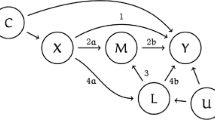Abstract
Causal inference lies at the center of epidemiologic research. In social epidemiology, two separate approaches to framing cause-effect relations have been considered: the counterfactual (or potential outcomes) framework and the theory of fundamental causes. The relations between these two frameworks have not yet been articulated. In this paper, I review the counterfactual and fundamental cause frameworks, and show how they capture different notions of cause-effect relations. Additionally, I show how the counterfactual and fundamental cause frameworks can be integrated to provide a more rigorous treatment of causality in social epidemiology. In particular, I show how counterfactual quantities can be used to evaluate predictions that follow from fundamental cause theory, assess the relations between and roles of various social resources in a given health disparity, and generate evidence on the potential interventions to mitigate health disparities.
Similar content being viewed by others
References
Papers of particular interest, published recently, have been highlighted as: •• Of major importance
Rosen G. A history of public health. Baltimore: Johns Hopkins University Press; 1993.
Hill A. The environment and disease: association or causation? Proc R Soc Med. 1965;58(5):295–300.
Rothman KJ. Causes. Am J Epidemiol. 1976;104(6):587–92.
Holland PW. Statistics and causal inference. J Am Stat Assoc. 1986;81(396):945–60.
Link BG, Phelan J. Social conditions as fundamental causes of disease. J Health Soc Behav. 1995;35(Extra Issue):80–94. The original paper introducing the notion that socioeconomic status acts as a fundamental cause of health outcomes, and outlining the implications of fundamental cause theory for health disparities.
Höfler M. The Bradford Hill considerations on causality: a counterfactual perspective. Emerg Themes in Epidemiol. 2005;2(1):11.
Auger N, Roncarolo F, Harper S. Increasing educational inequality in preterm birth in Quebec, Canada, 1981–2006. J Epidemiol Community Health. 2011;65(12):1091–6.
Cutler D, Lleras-Muney A. Education and health: evaluating theories and evidence. In: House J, Schoeni R, Kaplan G, et al., editors. Making Americans healthier: social and economic policy as health policy. New York: Russell Sage; 2008.
Kaufman JS, Cooper RS. Seeking causal explanations in social epidemiology. Am J Epidemiol. 1999;150(2):113–20. This article was the first to articulate the implications of the counterfactual framework for defining cause-effect relations in social epidemiology. The article emphasizes the difficulties encountered as a result of the non-random allocation of social exposures, but also comments on the problems that arise because of their “non-manipulable” nature.
Naimi AI, Kaufman JS. Counterfactual theory in social epidemiology: reconciling analysis and action for the social determinants of health. Curr Epidemiol Rep. 2015;2(1):52–60.
Krieger N. Does racism harm health? Did child abuse exist before 1962? On explicit questions, critical science, and current controversies: an ecosocial perspective. Am J Public Health. 2003;93(2):194–9.
Bollen KA and Pearl J. Eight myths about causality and structural equation models. In: Morgan SL, eds. Handbook of causal analysis for social research. Springer; 2013. p. 301–328.
Glymour C, Glymour MR. Commentary: race and sex are causes. Epidemiol. 2014;25(4):488–90.
Marcellesi A. Is race a cause? In: Philosophy of science assoc. 23rd biennial Mtg. San Diego: PSA; 2012.
Rubin DB. Causal inference using potential outcomes. J Am Stat Assoc. 2005;100(469):322–31.
Sekhon J. The Neyman-Rubin model of causal inference and estimation via matching methods. In: Box-Steffensmeier JM, Brady HE, and Collier D, eds. The oxford handbook of political methodology. Oxford University Press; 2008.
Robins JM, Greenland S. Causal inference without counterfactuals: comment. J Am Stat Assoc. 2000;95(450):431–5.
Hernán MA, Robins JM. Estimating causal effects from epidemiological data. J Epidemiol Community Health. 2006;60(7):578–86.
VanderWeele TJ. Explanation in causal inference: methods for mediation and interaction. Oxford: Oxford University Press; 2015.
Vanderweele TJ, Robinson WR. On the causal interpretation of race in regressions adjusting for confounding and mediating variables. Epidemiol. 2014;25(4):473–84.
Krieger N. On the causal interpretation of race. Epidemiol. 2014;25(6):937.
Holland PW. Causation and race. In: Zuberi T, Bonilla-Silva E, editors. White logic, white method: racism and methodology. Plymouth: Rowman & Littlefield Publishers, Inc; 2008. p. 93–110.
Krieger N. Refiguring “race”: epidemiology, racialized biology, and biological expressions of race relations. Int J Health Services. 2000;30(1):211–6.
Graves JL. The Emperor’s new clothes: Biological theories of race at the millennium. New Brunswick: Rutgers University Press; 2001.
Krieger N. Stormy weather: race, gene expression, and the science of health disparities. Am J Public Health. 2005;95(12):2155–60.
Feagin JR. Systemic racism: a theory of oppression. New York: Routledge; 2006.
Williams T. The Homestead Act: Our earliest national asset policy. Center for social development, Washington University. Working Paper 00–9. St Louis; 2000
Jacobson MF. Whiteness of a different color: European immigrants and the alchemy of race. Cambridge: Mass. Harvard University Press; 1998.
Nobles M. Shades of citizenship: race and the census in modern politics. Stanford: Stanford University Press; 2000.
Zinn H. A people’s history of the United States: 1492–2001. New York: HarperCollins; 2003.
Branch T. Parting the waters: America in the King years 1954–63. Simon & Schuster; 1988.
Branch T. Pillar of fire: America in the King years, 1963–65. Simon & Schuster; 1998.
Branch T. At Canaan’s edge: America in the King years, 1965–68. Simon & Schuster; 2006.
VanderWeele TJ, Hernán MA. Causal inference under multiple versions of treatment. J Causal Inference. 2013;1(1):1–20.
Hernán MA, VanderWeele TJ. Compound treatments and transportability of causal inference. Epidemiol. 2011;22(3):368–77.
VanderWeele TJ and Hernán MA. Causal effects and natural laws: towards a conceptualization of causal counterfactuals for non-manipulable exposures, with applications to the effects of race and sex. In: Berzuini C, Dawid AP, and Bernardinelli L, eds. Causality: statistical perspectives and applications. John-Wiley & Sons; 2012: 101–112.
VanderWeele TJ. Ignorability and stability assumptions in neighborhood effects research. Stat Med. 2008;27(11):1934–43.
Zuberi T. Deracializing social statistics: problems in the quantification of race. Ann Am Acad Pol Soc Sci. 2000;568:172–85.
Antonovsky A. Social class, life expectancy and overall mortality. Milbank Mem Fund Q. 1967;45(2):31–73.
Phelan JC, Link BG, Tehranifar P. Social conditions as fundamental causes of health inequalities: theory, evidence, and policy implications. J Health Soc Behav. 2010;51 Suppl 1:28–40. A review of the theory of fundamental causes and the empirical evidence supporting it, with a particular emphasis on the policy implications of the framework.
Phelan JC, Link BG. Is race a fundamental cause of inequalities in health? Annu Rev Sociol. 2015;41:311–30. This paper situates race in the fundamental cause framework. In particular, it outlines the relations between race, socioeconomic status, and health outcomes to show how race and racism generate inequities in power, prestige, freedom, neighborhood context, and health care, both with and independent of socioeconomic status, to shape health disparities.
Glymour MM, Acendano M, I K. Socioeconomic status and health. In: Berkman LF, Kawachi I, Glymour MM, editors. Social epidemiology. New York: Oxford University Press; 2014. p. 17–62.
Carpiano RM, Link BG, Phelan JC. Social inequality and health: future directions for the fundamental cause explanation. In: Lareau A, Conley D, editors. Social class: how does it work? New York: Russell Sage; 2008. p. 232–63.
Naimi AI, Schnitzer ME, Moodie EEM, et al. Mediation analysis for health disparities research. Am J Epidemiol. 2015; In Press.
Gertosio C, Meazza C, Pagani S, et al. Breast feeding: gamut of benefits Minerva Pediatr. 2015: Published Ahead of Print, May 29, 2015.
Allen JA, Li R, Scanlon KS, et al. Progress in increasing breastfeeding and reducing racial/ethnic differences—United States, 2000–2008 births. MMWR Morb Mortal Wkly Rep. 2013;62(5):77–80.
Lind JN, Ahluwalia IB, Perrine CG, et al. Prenatal breastfeeding counseling—Pregnancy Risk Assessment Monitoring System, United States, 2010. MMWR Surveill Summ. 2014;63(2):14–9.
Williams DR, Mohammed SA, Leavell J, et al. Race, socioeconomic status, and health: complexities, ongoing challenges, and research opportunities. Ann N Y Acad Sci. 2010;1186:69–101.
Author information
Authors and Affiliations
Corresponding author
Ethics declarations
Conflict of Interest
Ashley I. Naimi declares no conflict of interest.
Human and Animal Rights and Informed Consent
This article does not contain any studies with human or animal subjects performed by any of the authors.
Additional information
This article is part of the Topical Collection on Social Epidemiology
Rights and permissions
About this article
Cite this article
Naimi, A.I. The Counterfactual Implications of Fundamental Cause Theory. Curr Epidemiol Rep 3, 92–97 (2016). https://doi.org/10.1007/s40471-016-0067-7
Published:
Issue Date:
DOI: https://doi.org/10.1007/s40471-016-0067-7




